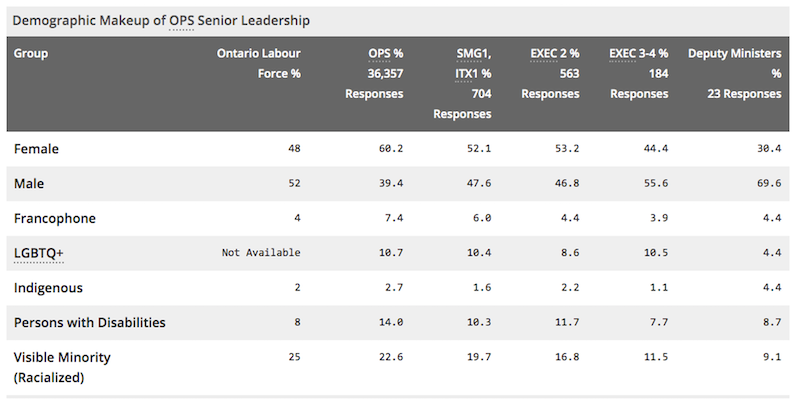Since the Equity Employment Act was introduced in Canada nearly 35 years ago, there have been significant improvements in the diversity of the Ontario Public Service (OPS). For example, visible minorities now make up approximately 25 per cent of Ontario’s labour force and 23 per cent of the OPS. But chronic, systemic challenges that prevent greater inclusivity of designated groups within the public service remain. This is especially true in senior leadership positions, where visible minorities only account for 11 per cent of senior executives and 9 per cent of Deputy Ministers in the OPS.

Representation in the public sector does not fare much better in other jurisdictions. Similar to the OPS, American government agencies are struggling to implement principles of equity, diversity, and inclusion. According to the Office of Personnel Management (OPM), visible minorities make up nearly 40 per cent of the population, yet account for just 22 per cent of senior leadership roles. Although visible minorities constitute 38 per cent of the federal workforce, whereas only 30 per cent hold supervisory or management positions.
In a knowledge-based economy like Canada, lack of representation in the public service is concerning because future prosperity depends on public sensitivity and engagement. The proliferation of visible minorities entering the labour market continues to change the structure of the workforce. It is increasingly important to remove barriers and create opportunities that enable OPS leaders to tap into the skills and abilities of visible minorities. Eligible retirements projected in the next five years are laying the conditions to diversify 30 per cent of managers and 34 per cent of executives.
Recognizing inherent problems
In recent years, OPS leadership has acknowledged that systemic discrimination exists within its workforce. A case in point occurred in February 2019. Two black women employed by the OPS filed a lawsuit against their unions and the provincial government. Their case alleges years of systemic racism and discrimination. Their repeated complaints were met with disbelief, disregard, and reprisal, causing them to be suspended and forced from the workplace. They claim to be hardworking employees who were over-scrutinized, exposed to anti-black stereotyping, and denied professional advancement.
Incidents like this reinforce the need to re-examine current policies and practices. The OPS needs to utilize data to take tangible, measurable actions to eliminate systemic barriers, discrimination, and harassment for all employees.
Shifting from thinking to action
Systemic discrimination in the workplace can become a pervasive part of an organization’s daily interactions and processes. It creates disadvantages for marginalized people over a prolonged period. Combating institutionalized discrimination requires a shift in thinking. Breaking down barriers and eliminating biases is a good place to start. More diverse and inclusive workplaces make society stronger. A government that lacks diversity lacks legitimacy. Research demonstrates the positive impact that diversity and inclusion have on creativity, problem-solving, innovation, attracting and retaining talent, understanding citizens’ needs, engaging employees, and building high-performing teams.
The Ontario Government needs to innovate if it wants to continue to compete globally. Nurturing an inclusive environment that values different people, perspectives, cultures, and experiences is a comparative advantage. Ontarians want leaders to think differently and to govern in a different way.
New thinking does not come easily. Capitalizing on diversity also calls for public managers to:
- Listen to the concerns and advice of employees;
- Embrace diversity principles as integral to the people management framework;
- Respond proactively against racism, discrimination, and harassment in the workplace; and
- Assist leaders in removing systemic barriers and planning for diverse, inclusive workplaces.
The ensuing cultural transformation will enable the OPS to build upon its reputation as one of Canada’s top-50 employers. Transformation takes time, commitment, and a willingness to openly discuss and influence how people value diversity. Active public engagement and partnering across sectors are necessary for developing the capacity to achieve societal goals. Leadership of the transformation agenda and results depend upon it.

